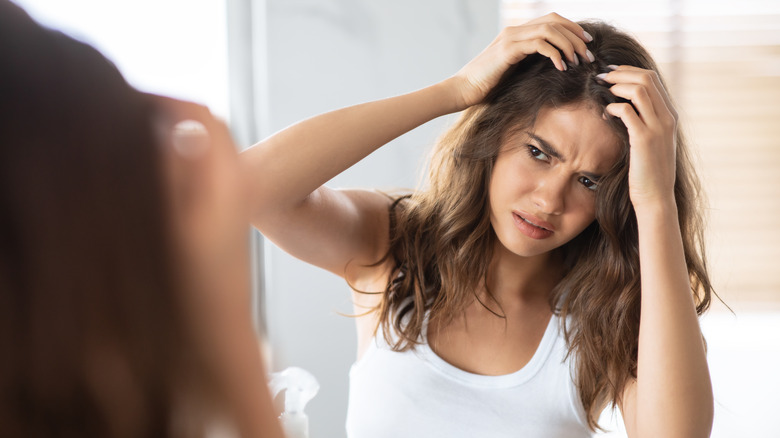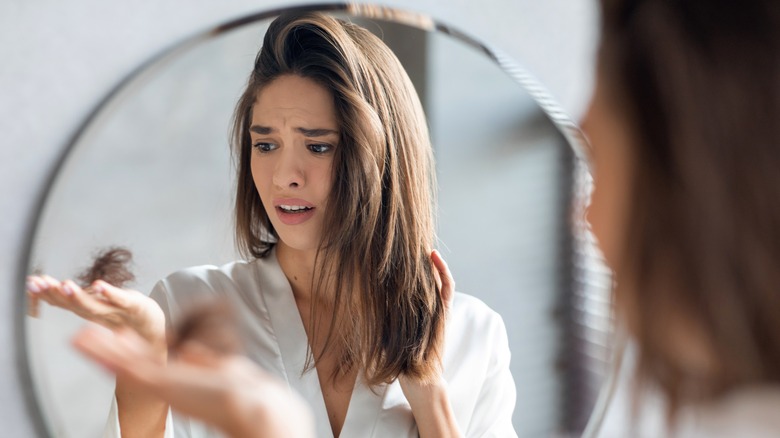When Should You Be Concerned About Thinning Hair?
If you have a close relationship with your hair, take decent care of it, and try to do what's best for its strands, it's no surprise you'd feel a tinge of worry if you notice more shedding than usual. Whether you're losing strands of hair gradually or the thinning has occurred all of a sudden, it can be a concerning thing to notice.
While it's true that the average person loses between 50 and 100 strands per day, according to the American Academy of Dermatology Association, you probably won't gather and count every single one that falls throughout the day to ensure your hair loss is normal. However, you may notice more clumps of hair in the shower or on your hairbrush than you typically do, which may set off alarm bells.
There are several reasons why hair loss and thinning occur, and not all are a reason to panic. In fact, many people experience hair loss and thinning, as it's very common and considered normal, regardless of age or gender (via Harvard Health Publishing). But how much is too much, and when should you be concerned?
If you are losing more hair than normal and experiencing other symptoms
If you've ever cleaned out your shower drain or pulled clumps of built-up hair from your hairbrush, it won't come as a shock to you that losing hair is normal. And what is "normal" for you may not be "normal" for another, so it's essential to rely on your usual hair shedding when determining your level of concern (via Harvard Health Publishing).
If an unusual amount of hair fall is occurring, like clumps on your pillowcase or significantly more strands falling out in a single shower, a trip to the doctor or dermatologist may be in order. "If one notices hair on the pillow or clumps of hair in the brush or comb, then that may be a sign of thinning or hair loss," Azza Halim, a board-certified anesthesiologist and physician told Sunday Riley.
Along with the amount of hair loss you are experiencing, you'll want to note what symptoms, if any, accompany it. That way, your doctor will have a better idea of how to treat it (per the American Academy of Dermatology). Stinging, itching, burning, swelling, and scaling are uncomfortable symptoms that can indicate unusual hair loss, which can help your doctor further understand the root of the issue. However, symptoms may not always be present.
Reasons for hair thinning and what you can do about it
There are several reasons for hair thinning and loss, from stress, hormones, and hairstyle choices to underlying health conditions and medications. According to the American Academy of Dermatology, regrowth can occur, as long as the hair follicle isn't completely destroyed and intervention occurs quickly enough. And if regrowth isn't possible, cosmetic procedures are in place to boost your confidence if desired (per WebMD).
What you don't want to do is take matters into your own hands, according to Dr. Azza Halim, board-certified anesthesiologist and physician, who spoke with Sunday Riley. "Hair loss must be diagnosed to determine the cause, then treat it accordingly, as some types are reversible and others are not." Your doctor may prescribe medications based on the diagnosis, so you may not want to rush to the local drugstore for OTC treatments before hearing from them first.
And if your hair loss is permanent? You aren't alone. Renee Reyes, who has alopecia and lost her hair at 19 years old, told Refinery29, "Since losing my hair, I cherish myself both on days I feel beautiful and days I don't. I've learned that beauty isn't a requirement for loving my body and myself." Remember, the societal pressure to be "perfect" can be a heavy burden, but the state of your hair doesn't have to be.


